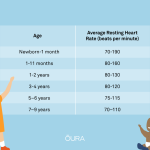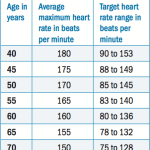Your heart beats around 3 billion times in your lifetime, pumping blood throughout your body and sustaining life as we know it. It’s a remarkable feat of physiology that often goes unnoticed – until something goes awry. So, what’s a normal pulse rate for an adult? Is it fast or slow?
What is Average Pulse Rate for an Adult?
In this post, we’ll delve into the world of cardiac rhythms and explore what constitutes a typical pulse rate for adults.
Why is Pulse Rate Important?
Pulse rate, also known as heart rate, is a vital indicator of your overall health. It’s influenced by factors like physical activity level, age, and underlying medical conditions. A normal pulse rate can vary depending on these variables, making it essential to understand what’s considered average for your demographic.
Understanding Average Pulse Rate for Adults
The American Heart Association defines a normal adult pulse rate as 60-100 beats per minute (bpm) at rest. However, this range can vary depending on factors like age and physical condition. For instance:
- Athletes or individuals who engage in regular exercise may have a resting pulse rate of 40-50 bpm.
- Elderly adults may have a higher average pulse rate due to decreased physical activity and potential underlying medical conditions.
In our next section, we’ll explore the factors that influence pulse rate and how to determine your individual average. Stay tuned!
Your heart beats around 3 billion times in your lifetime, pumping blood throughout your body and sustaining life as we know it. It’s a remarkable feat of physiology that often goes unnoticed – until something goes awry. So, what’s a normal pulse rate for an adult? Is it fast or slow?
What is Average Pulse Rate for an Adult?
In this post, we’ll delve into the world of cardiac rhythms and explore what constitutes a typical pulse rate for adults.
Why is Pulse Rate Important?
Pulse rate, also known as heart rate, is a vital indicator of your overall health. It’s influenced by factors like physical activity level, age, and underlying medical conditions. A normal pulse rate can vary depending on these variables, making it essential to understand what’s considered average for your demographic.
Understanding Average Pulse Rate for Adults
The American Heart Association defines a normal adult pulse rate as 60-100 beats per minute (bpm) at rest. However, this range can vary depending on factors like age and physical condition. For instance:
- Athletes or individuals who engage in regular exercise may have a resting pulse rate of 40-50 bpm.
- Elderly adults may have a higher average pulse rate due to decreased physical activity and potential underlying medical conditions.
In addition to age and physical condition, other factors that can influence your pulse rate include:
- Stress levels: High stress levels can cause your heart rate to increase.
- Circulation: Poor circulation can lead to a slower pulse rate.
- Medications: Certain medications, such as beta blockers, can slow down your heart rate.
To determine your individual average pulse rate, you can try the following:
- Take your pulse when you’re sitting or standing still for at least 10 minutes.
- Count the number of beats in a minute to get an accurate reading.
Remember, a normal pulse rate is just one aspect of overall health. It’s essential to combine this information with other vital signs, such as blood pressure and body temperature, to get a comprehensive picture of your well-being.
In our next section, we’ll explore the factors that influence pulse rate and how to determine your individual average. Stay tuned!
Learn more about normal heart rates for different age groups Take a pulse check with the American Heart AssociationGet Expert Medical Guidance
Consult with a medical expert and get personalized advice on maintaining your overall health.
Start chatYour heart beats around 3 billion times in your lifetime, pumping blood throughout your body and sustaining life as we know it. It’s a remarkable feat of physiology that often goes unnoticed – until something goes awry. So, what’s a normal pulse rate for an adult? Is it fast or slow?
What is Average Pulse Rate for an Adult?
In this post, we’ll delve into the world of cardiac rhythms and explore what constitutes a typical pulse rate for adults.
Why is Pulse Rate Important?
Pulse rate, also known as heart rate, is a vital indicator of your overall health. It’s influenced by factors like physical activity level, age, and underlying medical conditions. A normal pulse rate can vary depending on these variables, making it essential to understand what’s considered average for your demographic.
Understanding Average Pulse Rate for Adults
The American Heart Association defines a normal adult pulse rate as 60-100 beats per minute (bpm) at rest. However, this range can vary depending on factors like age and physical condition. For instance:
- Athletes or individuals who engage in regular exercise may have a resting pulse rate of 40-50 bpm.
- Elderly adults may have a higher average pulse rate due to decreased physical activity and potential underlying medical conditions.
As we’ve seen, the average pulse rate for an adult can vary significantly depending on individual factors. But what’s key is understanding your own unique pulse rate – and how it relates to your overall health.
Final Insights
By taking control of your heart health and monitoring your pulse rate, you’re one step closer to a longer, healthier life. Remember that a normal pulse rate is just the starting point – it’s what you do with that information that truly matters.
Conclusion
In conclusion, understanding average pulse rate for an adult is crucial for maintaining overall health and detecting potential issues early on. By recognizing the importance of pulse rate and taking steps to monitor your own heart health, you’re empowered to make informed decisions about your well-being – and take control of your journey towards a healthier, happier you.
2 week old puppy a bloated condition: As a new pet parent, it’s natural to worry about your pup’s health. If your 2-week-old puppy is showing signs of bloating, this article will guide you through the possible causes and treatments. Learn how to recognize warning signs and get expert tips on what to do if your little one is feeling uncomfortable.
Thank you for visiting our online retail store – your questions answered: Did you have any burning questions about shopping with us? This article addresses common queries and provides helpful information on topics such as returns, shipping, and more. Take a minute to check out the answers to your most pressing concerns.



